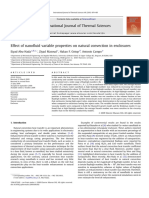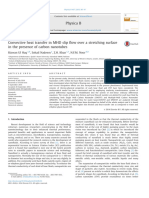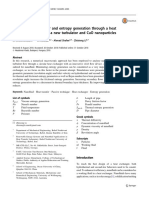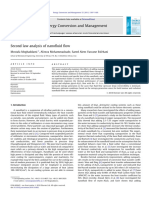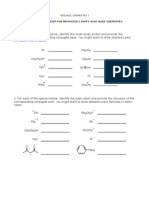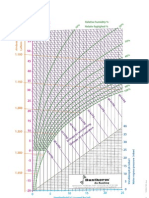INTRO5
INTRO5
Uploaded by
solomonCopyright:
Available Formats
INTRO5
INTRO5
Uploaded by
solomonCopyright
Available Formats
Share this document
Did you find this document useful?
Is this content inappropriate?
Copyright:
Available Formats
INTRO5
INTRO5
Uploaded by
solomonCopyright:
Available Formats
International Journal of Advances in Engineering Science and Technology 39
Available online at www.ijaestonline.com ISSN: 2319-1112
Thermo-Physical Properties of Nano Fluids- A
Review
Dharmendra kumar Saini 1, Ghanshayam Das Agarwal 2
1- 2
Departmentof Mechanical Engineering
1-2
Malviya National Institute of Technology Jaipur
1
Email- dharmendrasaini142@gmail.com
Abstract- Nanofluid is one of the best outcomes of nano-techonology advancement. Nanifluid can be considered
as a fluid rather than solid-fluid mixture. There is different properties enhancement in the base fluid using
nanoparticles i.e. thermal conductivity, heat transfer coefficient, density, viscosity, specific heat etc. Having
improved thermo physical properties, nanofluids can be used as a better heat transfer fluid in many engineering
applications such as radiator, heat pipe, solar collectors, chillers etc. The most important thermal properties
are thermal conductivity and heat transfer coefficient as well as viscosity. It is very complex and difficult to
experimentally estimate these thermal properties for nanofluids at different concentration of nano particles.
Many researchers have proposed mathematical and analytical works in the literatures for the determining of
these thermal properties. A brief review of some common theoretical and analytical models for estimation of
thermal properties is presented and also comparisons are made with experimental works in this paper, which
can be frequently used.
Keywords – Nanofluid, Thermal Conductivity, Heat Transfer Coefficient, Nanoparticle, Etc.
I. Introduction
Development in nano-techonology derives to a new class fluid named as nanofluid. A Nanofluid is a dilute suspension
of nano-metered sized particles in base fluid (ethylene glycol, water, engine oil, etc.). Nanometered sized particles
may be metallic or nonmetallic. Nanofluids have the potential of improved thermal-physical properties (thermal
conductivity, heat transfer coefficient, viscosity, density, heat capacity, etc.).
A large number of theoretical and experimental research works have been conducted since Maxwell [1] publication
on suspension of solid particles. Choi et al. [2] first used the term nanofluid proposing heat transfer fluid in Argonne
Laboratory. A large number of useful studies have been carried out related to nanofluids properties by Eastman et al.
[3], Lee and Choi [4], Jang and Choi [5], Heris et al. [6]. Most of the studies show the enhancement in heat transfer
for the nanofluids than the base fluids. From the basic principle of thermal conductivity solid metal has higher thermal
conductivity i.e., thermal conductivity of copper at room temperature is about 700 times greater than water and about
3000 times greater than engine oil. This is basically because of small particle size and large surface to volume ratio of
nanoparticles. Lee and Choi [4], Chein and Huang [7] found the enhancement in heat transfer in nanofluid than the
conventional fluid. Pak and Choi [8], li and Xuan [9] first calculated Nusselt number in laminar and turbulent flow
for nanofluids. Viscosity is a flow property that affects the pumping power and pressure drop in laminar flow.
Convective heat transfer also depends on the viscosity of fluid. Einstein [10] first developed the nanofluid viscosity
formula. Density of nanofluids also increased with concentration of nanoparticles. Heat capacity is also an important
property to find out the thermal performance of nanofluids. The purpose of this paper is to provide an understanding
about thermo-physical properties of nanofluids such as (thermal conductivity, coefficient of heat transfer, density,
viscosity, heat capacity etc.) and properties characteristic with respect to nanoparticle concentration. Many researchers
have developed correlations for the determination of thermo-physical properties of nanofluids. In this paper some
important and commonly used property relations for nanofluids are presented.
ISSN: 2319-1120 /V5N1: 39-45 © IJAEST
IJAEST, Volume 5, Number 1
KONDA. HARI KRISHNA et al.
Nomenclature
Cp Heat capacity(J/kg-K) A Constant
B2,x Depolarization factor along
the x- symmetrical axis H Heat transfer coefficient, W/m2-K
kB Boltzmann constant ( kB=1.381× 10ିଶଷJ/K)
k Thermal conductivity W/m-k
n Empirical shape factor Nu Nusselt number
Pe Peclet number Pr Prandtl number
Re Reynolds number T Temperature (°C)
Greek Symbols
α Aspect ratio of nanoparticles
β Ratio of the nanolayer thickness to the original particle radius
β=h/r
γ Ratio of nanolayer thermal conductivity to particle thermal conductivityγ = klayer / kp
ν Dynamic viscosity
φ Volume fraction of nanoparticles in suspension
ߤ
ᴪ Particle sphericity
Viscosity
ρ Density
Subscripts
b Base fluid
eff Effective
nf Nano fluid
np Nano particles
II. THERMAL CONDUCTIVITY
A. Watermark embedding algorithm –
When high conductive nanoparticles are added in the base fluid, having relatively low thermal conductivity, there is
remarkably increase in thermal conductivity of nanofluids. Some postulate that the thermal conductivity of nanofluids
is because of the nanoparticle’s Brownian motion which produces micro-mixing. Some researchers have suggested
that the enhancement is due to the layering of liquid molecules near the solid nanosized particles. The mechanism for
thermal conduction between liquid and solid particles is not clear. But there are some empirical relations that can be
used to find out thermal conductivity of two phase mixture solution (dispersed solution).
The effective thermal conductivity for a two-phase mixture consisting of a continuous and discontinuous phase has
been conducted by Maxwell [1] and the effective thermal conductivity Keff is given by:
Where K1 and K2 are the thermal conductivity of the liquid and the solid particle respectively and ߮is the particle
Keff,Maxwell/K1=2K2+K1+߮(K2-K1)/2K2+K1-2߮(K2- K1) (1)
volume fraction. Hamilton and Crosser [11] modified Maxwell work for none spherical particles and introduced the
shape factor (n). Yu and choi [12] modified the Maxwell model to find out real mechanism of improvement in thermal
conductivity. They assumed that base fluid molecules form a layered structure around the solid particles. This layer
mechanism can explain the enhancement in effective thermal conductivity. While calculating Keff for nano fluid yu
and choi assumed higher thermal conductivity of nanolayer (Klayer) than the base liquid conductivity (K1). When the
nano layer is combined with the nanoparticle, an equivalent nano particle with thermal conductivity of Keq is
introduced.
It is important to note that the effective thermal conductivity of nanofluids depends on the thermal conductivity of
solid nano-sized particles and base fluid, particle volume fraction, shape of particles, size of particles and the thermal
conductivity of nano-layer (equivalent nanoparticle).
Bhattacharya et al. [13] developed a correlation to calculate effective thermal conductivity of nanofluids using
Brownian motion technique as follow:
ISSN: 2319-1120 /V5N1: 39-45 © IJAEST
Thermo-Physical Properties of Nano Fluids- A Review
41
keff = ߮knp+(1‒߮)kb (2)
The model shows good agreement with thermal conductivity of experimental result.
Table 1: Analytical models on thermal conductivity of nanofluids – a summary
Investigator Formula (keff/kb) Remarks
Hamilton Kp+(n-1)Kb –(n-1) ϕ(Kb-Kp) /Kp+(n-1)Kb+ ϕ(Kb-Kp) for non-spherical particle
And crosser [11] Kp/Kb˃100 (n=3/ᴪ)
ࡷ ࡷ
൘ࡷ ି ൘ࡷ ି
1+ 3൭ࡷ ࢈
൱ φ+ቌ ൭ࡷ ࢈
൱ +∙∙∙∙∙∙∙∙∙∙∙∙ቍ ࣐
൘ࡷ ା ൘ࡷ ା
Jeffrey [14] Spherical particle
࢈ ࢈
ࡷ
1+൬ ൘ࡷ ൰ ࣐ + ࢈࣐
࢈
Lu-Lin [15] Spherical and non-spherical particle
ࡷࢋ ାࡷ࢈ ା൫ࡷࢋ ିࡷ࢈ ൯ሺିࢼሻ ࣐
ࡷࢋ ାࡷ࢈ ି൫ࡷࢋ ିࡷ࢈ ൯ሺାࢼሻ ࣐
Yu and choi [12] A modified Maxwell and Hamilton Crosser
Model respectively
ಮ
ሺି࣐ሻା࣐ ࡷࢉ ሺ࢘ሻሺ࢘ሻ/[ࡷࢉሺ࢘ሻାࡷ࢈ ]ࢊ࢘
ಮ
ሺି࣐ሻା࣐ ࡷ࢈ ሺ࢘ሻሺ࢘ሻ/[ࡷࢉሺ࢘ሻାࡷ࢈ ]ࢊ࢘
Wang et al. [16] A fractal model based on effective medium
Approximation and fractal theory
ࡷࢋࢌࢌିࡷ࢈
ቀ − ቁ +
࣐
ࢻ ࡷࢋࢌࢌ ାࡷ࢈
Xue and Xu [17] A modified Bruggeman model including effect of
࣐ ൫ࡷࢋࢌࢌ ିࡷ ൯ሺࡷ ାࡷ ሻିࢻሺࡷ ିࡷ ሻሺࡷ ିࡷࢋࢌࢌ ሻ
ࢻ ൫ࡷࢋࢌࢌିࡷ ൯ሺࡷ ାࡷ ሻାࢻሺࡷ ିࡷ ሻሺࡷ ିࡷࢋࢌࢌ ሻ
Interfacial shells
ࢨ ࣐ ࢀ
+ ࢨ ࣐ࢀ +
ିࢨ ࣐ࢀ
Xie et al. [18] Includes effect of nanolayer
+
࣋ ࣐
ට࣊࢘
ା࢈ିሺ࢈ିሻ࣐ ࡷ ࢀ
ା࢈ାሺ࢈ିሻ࣐ ࢈ ࢉࣁ
Xuan et al.[20] . Includes effect of the random motion of
+ࢉ
Suspended nanoparticles as well as Interfacial interactions
ࡷ ࢀ ࢿ࢘࢈
࣊ࣁࢊ ࡷ࢈ ሺିࢿሻ࢘
Kumar et al. [21] Includes particle size, concentration,
And temperature
ࡷ࢈ ࡾࢋࢊ ࡼ࣐࢘
ࢊ࢈
ࢊ
Jang and Choi [22] Kb(1 −φ) +kP+3C Four modes included
(1+ Aࡾࢋ ࡼ࢘. ࣐)[ ]
ା࢈ାሺି࢈ሻ࣐
ା࢈ିሺି࢈ሻ࣐
Prasher [23] Effect of convection of the liquid near the
Particle included
+ × ࢼ࣐࣋ࡼ ࡼ ට
ࡷࢋࢌࢌ,ࡹࢇ࢞࢝ࢋ ࢀ ࢌሺࢀ,࣐ሻ
ࡷ࢈ ࣋ࡼ ࡰ ࡷ࢈
Koo and Surrounding liquid motion with randomly
Kleinstreuer [24] Moving nanoparticles considere
II. CONVECTIVE HEAT TRANSFER COEFFICIENT
The enhancement in coefficient of heat transfer gives better described phenomenon than enhancement in thermal
conductivity because of its relation to size of equipment. Increment in coefficient of convective heat transfer is because
of presence of dispersed nanoparticles, which intensify the turbulence of the base fluid. Buongiorno [25] developed a
two component four-equation correlation non-homogeneous model for mass, momentum, and heat transfer in
nanofluids. Buongiorno finally concluded that only Brownian diffusion and thermophoresis are important
characteristics in nanofluids. The random motion of nanoparticles causes slip velocity between solid and liquid layer.
Pak and Choi [8] did the experiment on turbulent heat transfer of nanofluids by using Al2O3 and TiO2 dispersed
ISSN: 2319-1120 /V5N1: 39-45 © IJAEST
IJAEST, Volume 5, Number 1
KONDA. HARI KRISHNA et al.
nanoparticles in water. Xuan and Li [9] did theoretical study on single-phase flow for the turbulent and developed the
Nunf=hnf d/Knf=0.0059൫1.0 + 7.6286߮ .଼଼ ܲ݁ௗ .ଵ ൯ܴ݁ .ଽଶଷ଼ ܲݎ .ସ (3)
heat transfer correlation from the experimental data is as follows:
Nunf=hnf d/Knf=0.4328൫1.0 + 11.25߮ .ହସ ܲ݁ௗ .ଶଵ଼ ൯ܴ݁ .ଷଷଷ ܲݎ .ସ
For laminar flow Xuan and Li [15] also provide a correlation:
(4)
The Peclet number, Pe describes the effect of thermal dispersion caused by micro-convective and micro diffusion of
the suspended nanoparticles. forced convective heat transfer depend on Reynolds and Prandtl’s numbers, temperature
, vol. fraction (particles), the dimensions and shape of nano-sized particles. Xuan and Roetzel [26] proposed the
following function for calculating Nusselt number:
൫ఘ ൯
Nunf=݂ ቈܴ݁, ܲݎ, ൫ఘ , ߮, ݏ ݈ܽܿ݅ݐݎܽℎܽ݁, ݂݈ݕݎݐ݁݉݁݃ ݓ
൯
(5)
Generally two correlations are used to find out the Nusselt number as a function of Reynolds number and prandtl
number:
Nunf=0.086Re0.55Pr0.5 for constant wall flux. (6)
The given correlations are valid for Re ≤ 1000, 6 ≤ Pr ≤ 753, and ߮ ≤ 10%. Wongwises et al. [27] did an experiment
Nunf=0.028Re0.35Pr0.36 for constant wall temperature. (7)
using TiO2-water nanofluids under turbulent flow conditions. He used a horizontal double-tube counter flow heat
exchanger. They observed increment of (6– 11%) heat transfer coefficient for the nano-fluid (TiO2-water) compared
to pure water. Heris et al. [6] also gave a result of increment of heat transfer coefficient (40%) for the nanofluid
(Al2O3/water).For fully developed laminar flow under constant wall temperature boundary condition:
Nunf=hnf d/Knf=3.657 (8)
ఓ್
And for the turbulent flow, the Petukhof–Krillov [28] correlation
ቀ ቁ
ሺ/଼ሻோ
భ మ ఓೢ
Nunf=hnfd/Knf= (9)
మ
ଵ.ାଵଶ.ቀ ቁ ሺ య ିଵሻ
ఴ
f = (1.82logଵ ܴ݁ − 1.64)-2.
Where n = 0.11 for Tw˃Tb, n = 0.25 for Tw<Tb, and n = 0 for constant properties of gases with
Above correlations show good agreement with experimental results within the boundary conditions. The convective
heat transfer coefficient increases with increase in Reynolds number, because of the increase in the flow velocity
causes an enhancement in the motion of the dispersed nanoparticles. The increase in particle volume fraction in the
base fluid, there is increment in the convective heat transfer coefficient. This may be because of more inter particle
collisions and enhanced surface area of heat transfer, with theincreased volume fractions.
Table 2: Models of effective heat transfer coefficient
Investigator Nano-fluids Correlations
Pak and Choi [8] Al2O3-water, TiO2-water,Turbulent Nunf=0.021Re0.8Pr0.5
Das et al. [29] Al2O3-water, pool boiling Nunf=CRemPr0.4
Xuan and Li [9] CuO-water, turbulent Nunf=0.0059(1+∅.ૡૡ
ࢋ.
)Re0.9238Pr0.4
IV. VISCOSITY
Analysis of viscosity is required to determine behavior of heat transfer fluids. Einstein [10] calculated the effective
viscosity of solution having spherical solid particles in the base fluid using hydrodynamic equations. He derived the
following equations:
μeff =(1+2.5φp)μb (10)
This formula has some limitations, It does not include structure and particle-particle interaction and limited to a certain
particle concentrations. Mooney [21] suggested a model for higher concentrations of interacting spherical solid
particles suspensions is as follows:
അക
ቀ ቁ
μnf/μb=݁ భషೖക (11)
ISSN: 2319-1120 /V5N1: 39-45 © IJAEST
Thermo-Physical Properties of Nano Fluids- A Review
43
Where k is self-crowding factor. Batchelor [30] modified Einstein’s viscosity equation by introducing Brownian
μnf / μb=(1+2.5 ߮ + 6.5߮ ଶ)
motion effect. He suggested a model by considering isotropic suspension of rigid and spherical nanoparticles.
(12)
If the particle volume concentration (߮) is increased then the nanofluids with bigger size particles shows higher
viscosity than the smaller size particles based nanofluids. Almost every research showed that addition of nanoparticle
even at a low volume fraction in the base fluid has significant influence the viscosity.
Brinkman [31] modified Einstein’s equation for the use of particle concentration up to 4% and developed a formula:
μnf / μb=(1-߮)2.5 (13)
This formula generally used is to calculate effective viscosity. Pak and Cho [8] developed a viscosity model based on
μnf / μb=(1+3.99 ߮ + 533.9߮ ଶ )
particle volume fraction taking room temperature as reference.
(14)
Table 3: Models of effective viscosity
μeff / μb = (1 + 7.3 ࣐ + 123 ࣐ )
Models Effective Viscosity Remarks
μeff / μb= (1 + 5.45 ࣐ + 108.2࣐ )
Maiga et al. [32] Al2O3- water, dp = 28nm
Buongiorngo et al. [25] TiO2 – water, dp = 27nm
μeff / μb = (1+0.025࣐ + 0.015࣐ )
μeff / μb = (1 + 23.09 ࣐ + 1525.3࣐ )
Nguyen et al. [33] Al2O3- water, dp = 29nm
Khanafer et al. [34] Al2O3- water, dp = 13nm
Nguyen et al. [33] μeff / μb = (1.475 - 0.319࣐ + 0.051࣐ + 0.009࣐ ) CuO – water, dp = 29nm
Effect of temperature and volume fraction on effective viscosity
࣐ = %, Al2O3- water
࣐ = %, Al2O3- water
Nguyen et al. [33] μnf / μb= (1.125 – 0.007×T)
μnf / μb= (2.1275 – 0.0215×T + 0.0002×ࢀ )
Palm et al. [35] μnf / μb = (0.034 – 2 × ି T + 2 × ି T2) ࣐ = %,Al2O3- water
μnf / μb = (1.0226 + 0.0477 ࣐ – 0.0112࣐ ሻ
Namburu et al. [36] lnμnf=A+B/T CuO-ethylene glycol - water
࣐ ≤ %
Duangthongsuk and TiO2 – water, , dp = 21nm
Wongwises [27]
V. DENSITY
Density of any nanofluid is directly related to particle volume fraction (߮). It increases approximately in linear manner
with fraction volume. Density decreases with increase in temperature of fluid in non-linear manner. The basic reason
behind non-linear trend is difference in the coefficient of thermal expansion in base fluid and Nano particles. The density
of nano-fluids, ρnf can be simply estimated as:
ρnfcp,nf=(1-ϕ)ρfcp,p + ϕρpcp,p (15)
ρnf=mnf/vol.nf = (mf+mp)/(volf+volp) = (ρfvolf+ρpvolp)/ (volf+volp) (16)
The density may be determined from a simple rule of mixtures given by Pak and Choi (8)
ρnf=(1-ϕ)ρf+ϕρp (16)
Where ϕ is the volume fraction of dispersed phase, ρf is the density of the base fluid And ρp the density of nanoparticles.
VI. SPECIFIC HEAT
Specific Heat is a measure of heat energy that directly influences the heat transfer rate of Nano-fluids. For a given
volume concentration of Nano-particles in the base fluid, the specific heat can be found using a parallel mixture
rule:
ρnfcp,nf =(1-ϕ)ρfcp,p+ ϕρpcp,p (17)
Hence the specific heat capacity may be determined as
Cnf=Xnf/ρnf = (1-ϕ)ρfcp,p + ϕρpcp,p/ (1-ϕ)ρf+ϕρp (18)
Where Xnf = (ρc)nf
Gherasim et al. [37] discuss an alternative formulation, from the mixture formula:
Cnf = (1-ϕ)Cf + ϕCp (19)
ISSN: 2319-1120 /V5N1: 39-45 © IJAEST
IJAEST, Volume 5, Number 1
KONDA. HARI KRISHNA et al.
The specific heat of nanofluids decreases with increase in the fraction volume of nanoparticles and also it increases
with increase in the nanofluids temperature.
Table 4: Typical thermal parameters for nanoparticles and base fluids.
Substance Density Specific heat Conductivity
(kg/m3) (J/kg-K) (W/m-K)
Al2O3 4000 880 30
Copper 8920 390 401
Water 998 4190 0.58
Ethylene Glycol 1110 2470 0.258
VII.CONCLUSION
Thermophysical characteristics of nanofluids and their role in heat transfer enhancement are reviewed in this work.
General correlations for the effective thermal conductivity, viscosity, heat transfer coefficient, density and specific heat
capacity of nanofluids are provided. It can be said that nanofluids have greater heat transfer capability than those of
conventional heat transfer fluids. There is also effect on thermal conductivity, density, viscosity, heat transfer coefficient
and specific heat capacity of base fluid by adding Nanoparticles in base fluids. But there is pressure drop at the time of
addition of nanoparticles. It can be observed that thermo physical properties of nanofluids are dependent on the
nanoparticles size, shape, and volume fraction. The increment in the values of thermal conductivity, heat transfer
coefficient is up to a certain limit. Experimental results and the theoretical understanding of the mechanisms of the
nanoparticles are needed to justify for the heat transfer and fluid behavior of nanofluids. Further work is also needed
for the treatment of nanofluids as a two-phase flow since slip velocity between the particle and base fluid plays important
role on the heat transfer performance of nanofluids.
REFERENCE
1. C.Kleinstreuer, Y.Feng,“Experimental and theoretical studies of nanofluid thermal conductivity enhancement: a review”, Nanoscale
Research Letters 2011.
2. H.k.Patel, Dr. V.N.Bartaria, “Review and Experimental Comparison of Al2O3and Water Mixture Based Nano fluid Thermal
Conductivity as Heat Transfer Fluid”. IPASJ International Journal of Mechanical Engineering (IIJME) (2014).
3. S. George C, T.S.Krishnakumar “An Experimental investigation on the enhancement of forced convection heat transfer using TiO2-
water nanofluids in turbulent regime.”International Journal of Innovative Research in Science, Engineering and Technology Vol. 2
(2013).
4. S.Kakaç, A.Pramuanjaroenkij,“Review of convective heat transfer enhancement with nanofluids” International Journal of Heat and
Mass Transfer52(2009) 3187-3196.
5. X.Wang and A.S.Mujumdar,“A Review on nanofluids - part i:Theoretical and Numerical investigations”. Brazilian Journal of Chemical
Engineering, vol. 25, No. 4, pp. 613-630, (2008).
6. C.Yang, W.Li, A.Nakayama,“Convective heat transfer of nanofluids in a concentric annulus”. International Journal of Thermal Sciences
71 (2013) 249-257.
7. S.Sh.Hosseini, A.Shahrjerdi, Y.Vazifeshenas,“A Review of Relations for Physical Properties of Nanofluids” Australian Journal of
Basic and Applied Sciences, 5(10): 2011.
8. M. R.Azizian, H.Aybar, T. Okutucu “Effect of Nanoconvection due to Brownian Motion on Thermal Conductivity of Nanofluids”.
IASME / WSEAS International Conference on Heat Transfer, Thermal Engineering and Environment (hte '09).
9. Y. Yang, Z. George Zhang, Eric A. Grulke, William B. Anderson, Gefei Wu “Heat transfer properties of nanoparticle-in-fluid
dispersions (nanofluids) in laminar flow”. International Journal of Heat and Mass Transfer 48 (2005)1107–1116.
10. J. Albadr, S. Tayal, M. Alasadi “Heat transfer through heat exchanger using Al2O3 nanofluid at different concentrations”. Case Studies
in Thermal Engineering 1 (2013) 38-44.
11. K. Khanafer, K.Vafai,”A critical synthesis of thermophysical characteristics of nanofluids”. International Journal of Heat and Mass
Transfer 54 (2011) 4410-4428.
12. H.K.Gupta, G.D.Agrawal, J.Mathur,”An experimental investigation of a low temperature Al2O3-H2O nanofluid based direct absorption
solar collector”. Solar Energy 118 (2015).
ISSN: 2319-1120 /V5N1: 39-45 © IJAEST
Thermo-Physical Properties of Nano Fluids- A Review
45
13. N.Bozorgan and M.Shafahi,”Performance evaluation of nanofluids in solar energy: a review of the recent literature”. Bozorgan and
Shafahi Micro and Nano Systems Letters (2015)
14. P.C.Mishra, S.Mukherjee, S.k.Nayak A.Panda,”A brief review on viscosity of nanofluids”.Int Nano Lett (2014).
15. Y. Xuan, Q.Li,”Heat transfer enhancement of nanofuids”. International Journal of Heat and Fluid Flow 21 (2000)58-64.
ISSN: 2319-1120 /V5N1: 39-45 © IJAEST
You might also like
- Density-Functional Theory of Atoms and Molecules: Robert G. Parr and Weitao YangDocument20 pagesDensity-Functional Theory of Atoms and Molecules: Robert G. Parr and Weitao YangSaint Berlin Cruz CusacaniNo ratings yet
- MetallographyDocument480 pagesMetallographypawoe3064100% (3)
- UG Gas Properties ActivityDocument7 pagesUG Gas Properties Activityardianti widoriniNo ratings yet
- 03Document9 pages03fghfghrfjNo ratings yet
- Arfmtsv19 N1 P1 9Document9 pagesArfmtsv19 N1 P1 9lavadagopal10No ratings yet
- 1 s2.0 S0735193311001758 MainDocument8 pages1 s2.0 S0735193311001758 MainWadï AmlalNo ratings yet
- External ThreadDocument11 pagesExternal ThreadGURUDATT H MNo ratings yet
- Shahsavar2019 Article ImpactOfVariableFluidPropertieDocument13 pagesShahsavar2019 Article ImpactOfVariableFluidPropertieinfokartanegaraNo ratings yet
- Nano Natural ConvectionDocument10 pagesNano Natural ConvectionJiBuNo ratings yet
- Paper 5Document13 pagesPaper 5edabunadaNo ratings yet
- Applsci 11 01459 v2Document11 pagesApplsci 11 01459 v2pkvssraoNo ratings yet
- Thermal Management of Electronic Components Based On New Wave Bio-Inspired Structures and NanofluidsDocument27 pagesThermal Management of Electronic Components Based On New Wave Bio-Inspired Structures and Nanofluidssb8862No ratings yet
- Nano Fluid PDF (Research Paper)Document12 pagesNano Fluid PDF (Research Paper)Vicky SharmaNo ratings yet
- Thermal Conductivity of Nanofluids - A Review of The Existing Correlations and A Scaled Semi-Empirical EquationDocument20 pagesThermal Conductivity of Nanofluids - A Review of The Existing Correlations and A Scaled Semi-Empirical EquationMoutinhoRodriguesNo ratings yet
- 1 s2.0 S1290072907001263 Main PDFDocument9 pages1 s2.0 S1290072907001263 Main PDFMohamed-DeqSabriyeNo ratings yet
- A Comprehensive Model For The Enhanced Thermal Conductivity of Nanofluids PDFDocument5 pagesA Comprehensive Model For The Enhanced Thermal Conductivity of Nanofluids PDFMǾhămed TăwfiķNo ratings yet
- Paper KDocument9 pagesPaper KDEISA YANIANY DUSSAN RAMIREZNo ratings yet
- 2015, APT, Theoretical Analysis of Natural Convection Boundary Layer Heat and MassDocument12 pages2015, APT, Theoretical Analysis of Natural Convection Boundary Layer Heat and MassAtulNo ratings yet
- Experimental Investigations and Theoretical Determination of ThermalDocument7 pagesExperimental Investigations and Theoretical Determination of ThermalkemalNo ratings yet
- Used Oleymine To Achieve Stability Over 2 MonthsDocument59 pagesUsed Oleymine To Achieve Stability Over 2 Monthssaadthespidey177No ratings yet
- GoooooodDocument9 pagesGoooooodhossein soltanipourNo ratings yet
- CFD MgoDocument8 pagesCFD MgoSrini RaoNo ratings yet
- Finite Element Analysis For Sand and Paraffin Wax Nanoparticles in Propylene Glycol Water Mixture Based Hybrid Nanofluid Flow Over A SwirlingDocument25 pagesFinite Element Analysis For Sand and Paraffin Wax Nanoparticles in Propylene Glycol Water Mixture Based Hybrid Nanofluid Flow Over A SwirlingSaichand88No ratings yet
- Physica B 457201540-47 Full Publish-LibreDocument8 pagesPhysica B 457201540-47 Full Publish-LibreAbu Zafur Ziauddin AhmedNo ratings yet
- 2004 Heat Transfer Properties of Nanoparticle in Fluid Dispersions Nanofluids in Laminar FlowDocument10 pages2004 Heat Transfer Properties of Nanoparticle in Fluid Dispersions Nanofluids in Laminar FlowAnonymous 7BQxlt8cNo ratings yet
- Nanoparticles Suspended in Ethylene Glycol Thermal Properties andDocument7 pagesNanoparticles Suspended in Ethylene Glycol Thermal Properties andAbdullah AlkalaliNo ratings yet
- International Communications in Heat and Mass Transfer: Ningbo Zhao, Jialong Yang, Shuying Li, Qiang WangDocument10 pagesInternational Communications in Heat and Mass Transfer: Ningbo Zhao, Jialong Yang, Shuying Li, Qiang WangVlad MarţianNo ratings yet
- 120ME0337 Technical WritingDocument12 pages120ME0337 Technical Writingswaroopdash.201me256No ratings yet
- Paper 3Document9 pagesPaper 3edabunadaNo ratings yet
- IJEAS0306017Document5 pagesIJEAS0306017erpublicationNo ratings yet
- Results in PhysicsDocument7 pagesResults in PhysicsNomaNo ratings yet
- Transpiration Effects On Hybrid Nano Uid Ow and Heat Transfer Over A Stretching/shrinking Sheet With Uniform Shear OwDocument9 pagesTranspiration Effects On Hybrid Nano Uid Ow and Heat Transfer Over A Stretching/shrinking Sheet With Uniform Shear OwShafqat HussainNo ratings yet
- 2011, CorcioneDocument5 pages2011, CorcionetangtszloongNo ratings yet
- 1 s2.0 S1110016816302290 MainDocument9 pages1 s2.0 S1110016816302290 MainRoberto SilvaNo ratings yet
- Used Triton X-100 To Observe Stability Over 180 DaysDocument16 pagesUsed Triton X-100 To Observe Stability Over 180 Dayssaadthespidey177No ratings yet
- Heat Transfer by Nanofluid - Javad RostamiDocument9 pagesHeat Transfer by Nanofluid - Javad RostamiElver GonzalesNo ratings yet
- Thermophysical Property and Heat TransfeDocument9 pagesThermophysical Property and Heat Transfeamazingcars920No ratings yet
- 10 1016@j Ijrefrig 2019 02 035Document20 pages10 1016@j Ijrefrig 2019 02 035Billy KncrNo ratings yet
- Comparison Between Thermal Conductivity of TiO2/Benzene and CuO/Benzene Nanofluids in Heat PipeDocument5 pagesComparison Between Thermal Conductivity of TiO2/Benzene and CuO/Benzene Nanofluids in Heat PipeIJRASETPublicationsNo ratings yet
- Results in Physics: Tanzila Hayat, S. NadeemDocument8 pagesResults in Physics: Tanzila Hayat, S. NadeemzermiNo ratings yet
- MS Defence Presentation ElhamDocument51 pagesMS Defence Presentation ElhamMohamed H. ShedidNo ratings yet
- Hall Current and Morphological Effects On MHD Micropolar Non Newtonian Tri Hybrid Nanofluid Flow Between Two Parallel SurfacesDocument20 pagesHall Current and Morphological Effects On MHD Micropolar Non Newtonian Tri Hybrid Nanofluid Flow Between Two Parallel SurfacesRana EjazNo ratings yet
- 2018 - Bahmani - Investigation of Turbulent Heat Transfer and Nano Uid Ow in A Double Pipe Heat Exchanger CFDDocument10 pages2018 - Bahmani - Investigation of Turbulent Heat Transfer and Nano Uid Ow in A Double Pipe Heat Exchanger CFDAhmad Imam Rifa'iNo ratings yet
- Sheikholeslami2018 Article NanofluidHeatTransferAndEntropDocument9 pagesSheikholeslami2018 Article NanofluidHeatTransferAndEntropVikash SinghNo ratings yet
- A Numerical Exploration of The Comparative Analysis On Water and Kerosene Oil Based Cu-Cuo/Hybrid Nanofluid Flows Over A Convectively Heated SurfaceDocument15 pagesA Numerical Exploration of The Comparative Analysis On Water and Kerosene Oil Based Cu-Cuo/Hybrid Nanofluid Flows Over A Convectively Heated SurfacespiliopoulosgrhgorhsNo ratings yet
- Thermal Conductivity Apparatus 2Document22 pagesThermal Conductivity Apparatus 2180763119046.arvindNo ratings yet
- Eulerian Eulerian Two Phase Numerical Simulation of Nanofluid Laminar Forced Convection in A Microchannel PDFDocument10 pagesEulerian Eulerian Two Phase Numerical Simulation of Nanofluid Laminar Forced Convection in A Microchannel PDFIrving GarciaNo ratings yet
- Moghaddami 2011Document9 pagesMoghaddami 2011nadir adelNo ratings yet
- Energy CompressedDocument11 pagesEnergy CompressedDr. Yedhu Krishnan RNo ratings yet
- Santra 2008Document10 pagesSantra 2008hassanNo ratings yet
- A Review On Nanofluid: Preparation, Stability, Thermophysical Properties, Heat Transfer Characteristics and ApplicationDocument17 pagesA Review On Nanofluid: Preparation, Stability, Thermophysical Properties, Heat Transfer Characteristics and ApplicationPriya TiwariNo ratings yet
- Thermal-Hydraulic Behavior of Lotus Like Structured rGO-ZnO Composite Dispersed Hybrid Nanofluid in Mini Channel Heat SinkDocument13 pagesThermal-Hydraulic Behavior of Lotus Like Structured rGO-ZnO Composite Dispersed Hybrid Nanofluid in Mini Channel Heat SinkMoutinhoRodriguesNo ratings yet
- Buoyancy Driven Heat Transfer ofDocument12 pagesBuoyancy Driven Heat Transfer ofMehmet Bahattin AkgulNo ratings yet
- 1 s2.0 S1877705813004785 MainDocument6 pages1 s2.0 S1877705813004785 MainpkvssraoNo ratings yet
- An Experimental Investigation On Heat Transfer Charact - 2019 - International CoDocument13 pagesAn Experimental Investigation On Heat Transfer Charact - 2019 - International CohenrymaryNo ratings yet
- Thermophysical and Dielectric Profiles of Ethylene Glycol Based Titanium Nitride (Tin - Eg) Nanofluids With Various..Document12 pagesThermophysical and Dielectric Profiles of Ethylene Glycol Based Titanium Nitride (Tin - Eg) Nanofluids With Various..Sathiyamoorthi RamalingamNo ratings yet
- Heat Transfer in Turbulent Nanofluids - Separation Flow Studies and Development of Novel CorrelationsDocument14 pagesHeat Transfer in Turbulent Nanofluids - Separation Flow Studies and Development of Novel CorrelationsMoutinhoRodriguesNo ratings yet
- Numerical Investigation of Transient Natural Convection and EntropyDocument15 pagesNumerical Investigation of Transient Natural Convection and EntropyAxel DorianNo ratings yet
- Experimental Thermal and Fluid Science: Salma Halelfadl, Patrice Estellé, Thierry MaréDocument7 pagesExperimental Thermal and Fluid Science: Salma Halelfadl, Patrice Estellé, Thierry MarélcandoNo ratings yet
- International Journal of Heat and Mass Transfer: Dan Zheng, Jin Wang, Zhanxiu Chen, Jakov Baleta, Bengt SundénDocument11 pagesInternational Journal of Heat and Mass Transfer: Dan Zheng, Jin Wang, Zhanxiu Chen, Jakov Baleta, Bengt SundénimhaNo ratings yet
- Enhanced Convective Heat Transfer Using Graphene Dispersed NanofluidsDocument9 pagesEnhanced Convective Heat Transfer Using Graphene Dispersed NanofluidsRoman RZNo ratings yet
- Sedighi 2014Document9 pagesSedighi 2014motemig144No ratings yet
- Becke 1988Document3 pagesBecke 1988bhelena868063No ratings yet
- Process For Preparing Microclustered WaterDocument4 pagesProcess For Preparing Microclustered WaterPedroRtowersNo ratings yet
- Chemical Analysis in Amine System OperationsDocument8 pagesChemical Analysis in Amine System OperationsAftab hasnatNo ratings yet
- Deep Traps in GaN-based Structures As Affecting The Performance of GaN DevicesDocument56 pagesDeep Traps in GaN-based Structures As Affecting The Performance of GaN Deviceshezabra2007No ratings yet
- Motion of ElectronDocument21 pagesMotion of ElectronMAGZNo ratings yet
- Bronst Acid Base QsDocument8 pagesBronst Acid Base QsIsta EgbetoNo ratings yet
- GelHandbookPart1 PDFDocument22 pagesGelHandbookPart1 PDFMario StrašniNo ratings yet
- Diagrama HXDocument2 pagesDiagrama HXRadu DinuNo ratings yet
- Direct Determination of Phosphite in Fertilizers by Amperometric TitrationDocument3 pagesDirect Determination of Phosphite in Fertilizers by Amperometric TitrationKarol Astrid Landines BarraganNo ratings yet
- Hyperbranched Polymers: New Selective Solvents For Extractive Distillation and Solvent ExtractionDocument19 pagesHyperbranched Polymers: New Selective Solvents For Extractive Distillation and Solvent ExtractionRaja Maizatulakmal0% (1)
- FCC and ParametersDocument18 pagesFCC and ParametersIOCPCNo ratings yet
- Corrosion 1Document2 pagesCorrosion 1M Nazal Sayyidi AkmalNo ratings yet
- Atomic Force Microscopy: Powerpoint Templates PowerpointDocument11 pagesAtomic Force Microscopy: Powerpoint Templates Powerpointruhi ranjanNo ratings yet
- Unit 4 Structure Unfolding TechniquesDocument29 pagesUnit 4 Structure Unfolding TechniquesvijayNo ratings yet
- Rask 1989Document27 pagesRask 1989Ruxandra SimionNo ratings yet
- General Principles and Processes of Isolation Elements: Chapter - 6Document28 pagesGeneral Principles and Processes of Isolation Elements: Chapter - 6Mukul MathurNo ratings yet
- Carnot Heat EngineDocument10 pagesCarnot Heat EngineSheraz Ali100% (1)
- The Latex Extract of Nypa FuticansDocument30 pagesThe Latex Extract of Nypa FuticansGM DeedsNo ratings yet
- Unit IVDocument71 pagesUnit IVBharathi KannaNo ratings yet
- Chemistry 432 Problem Set 5 Spring 2018 SolutionsDocument6 pagesChemistry 432 Problem Set 5 Spring 2018 SolutionsLovely yadavNo ratings yet
- 12 RadioactivityDocument62 pages12 RadioactivityAMRA IQBALNo ratings yet
- Effect of EO and PO Positions in Nonionic Surfactants On Surfactant Wu2005Document7 pagesEffect of EO and PO Positions in Nonionic Surfactants On Surfactant Wu2005Alfonso Dominguez GonzalezNo ratings yet
- Electrochemistry Worksheet-IDocument2 pagesElectrochemistry Worksheet-ISrijit SahaNo ratings yet
- Academic Guidebook Chemical EngineeringDocument18 pagesAcademic Guidebook Chemical EngineeringFarhandi Fadillah FedrizalNo ratings yet
- Chemical Reaction and Equation - Class Notes - Hope (Backlog Series)Document139 pagesChemical Reaction and Equation - Class Notes - Hope (Backlog Series)gaustricnelsonNo ratings yet
- The Strong Nuclear ForceDocument4 pagesThe Strong Nuclear ForceMeutia NurvicaNo ratings yet









